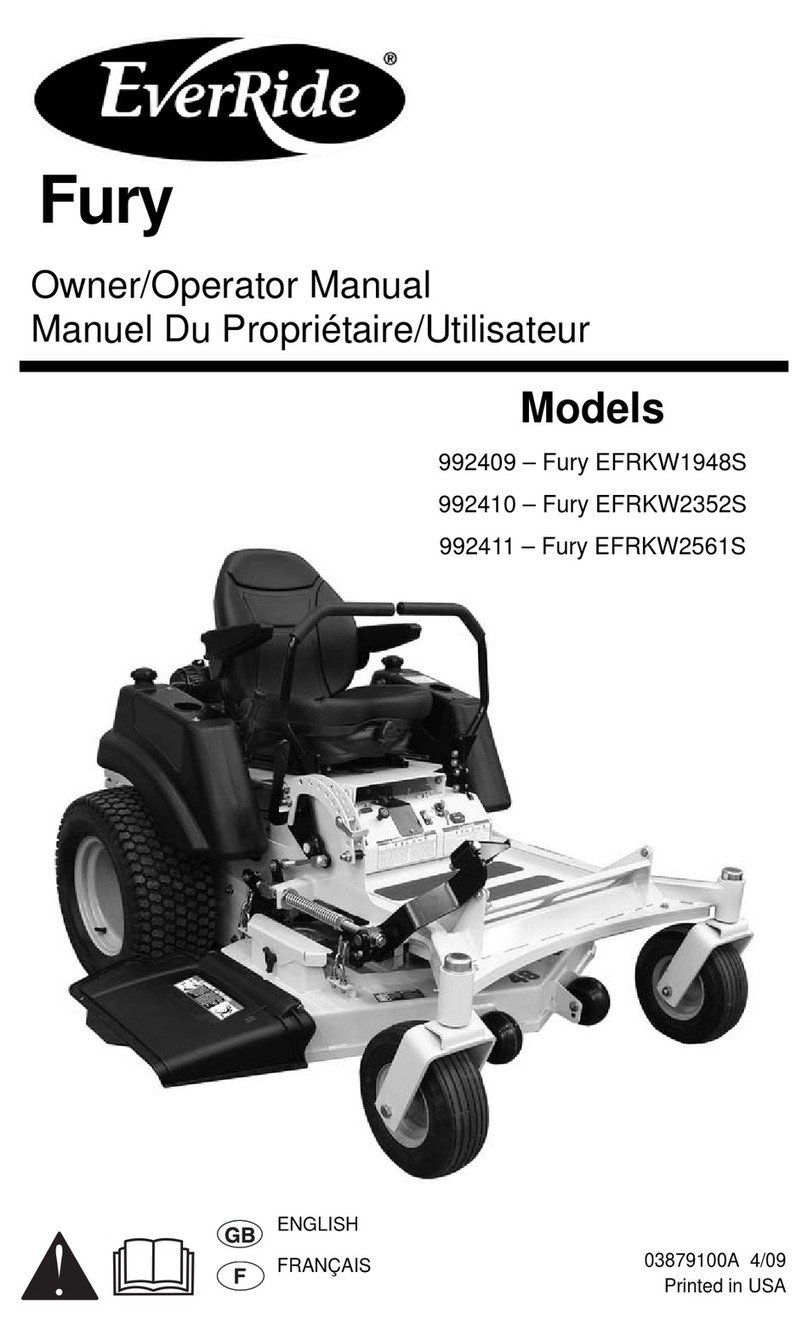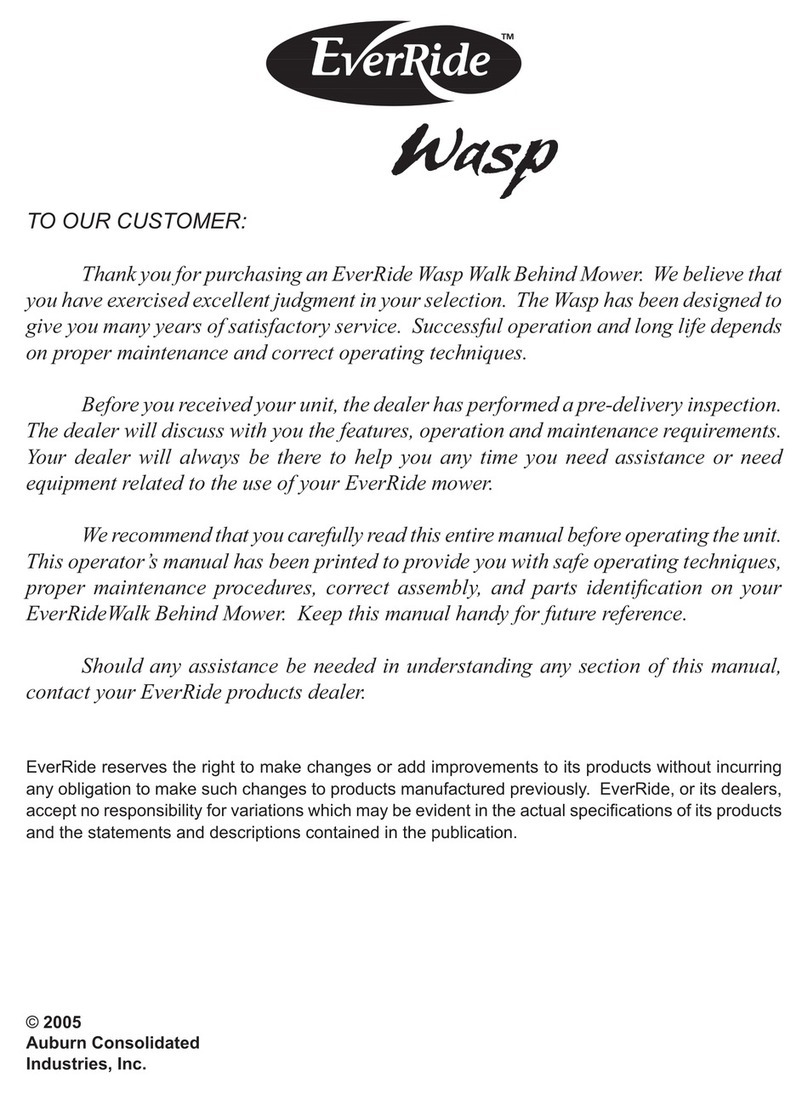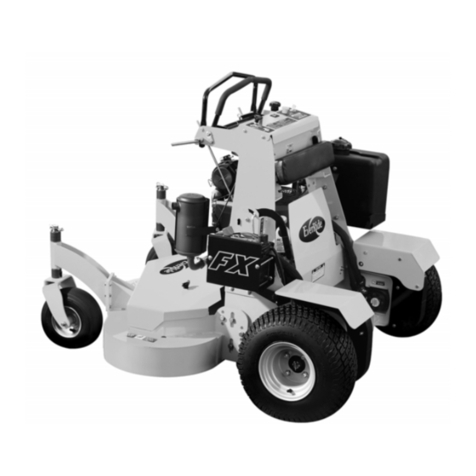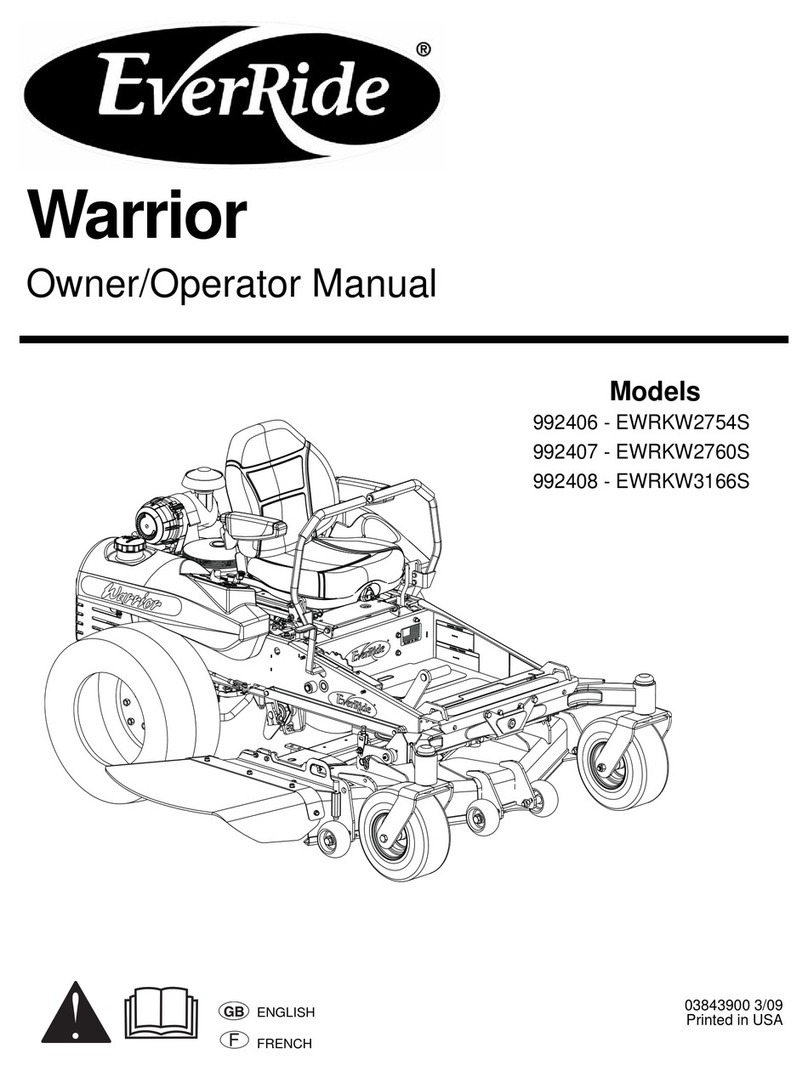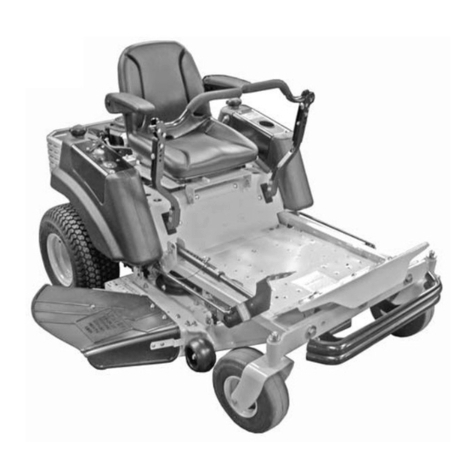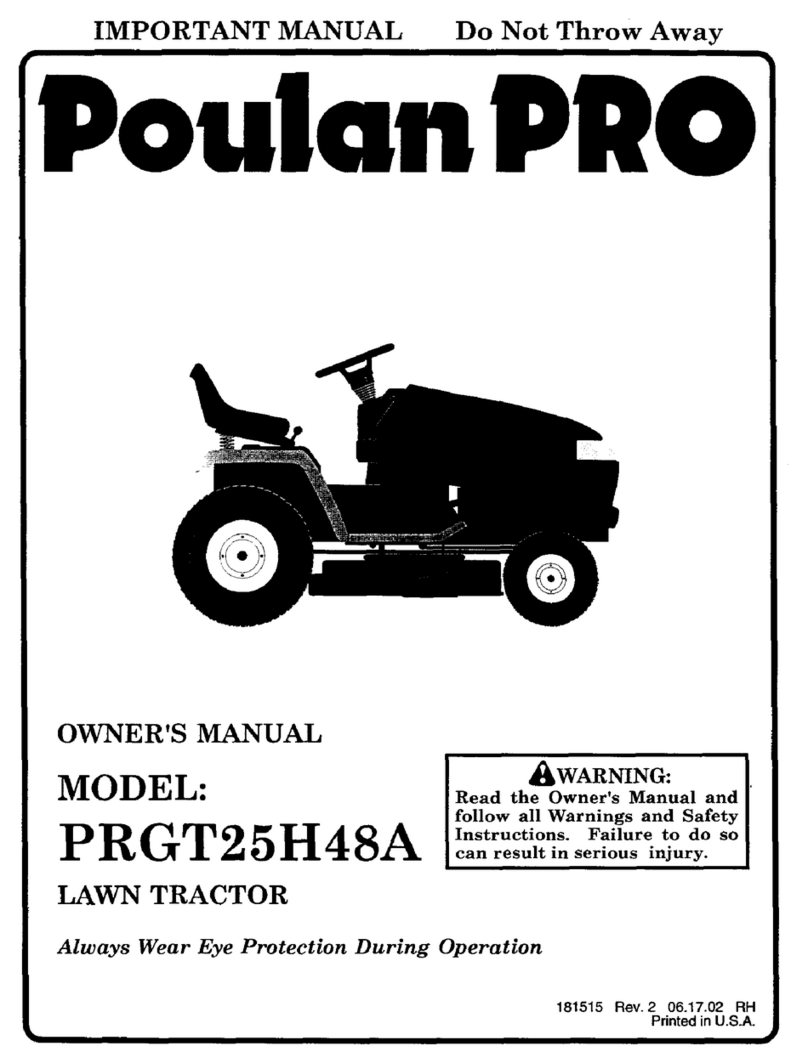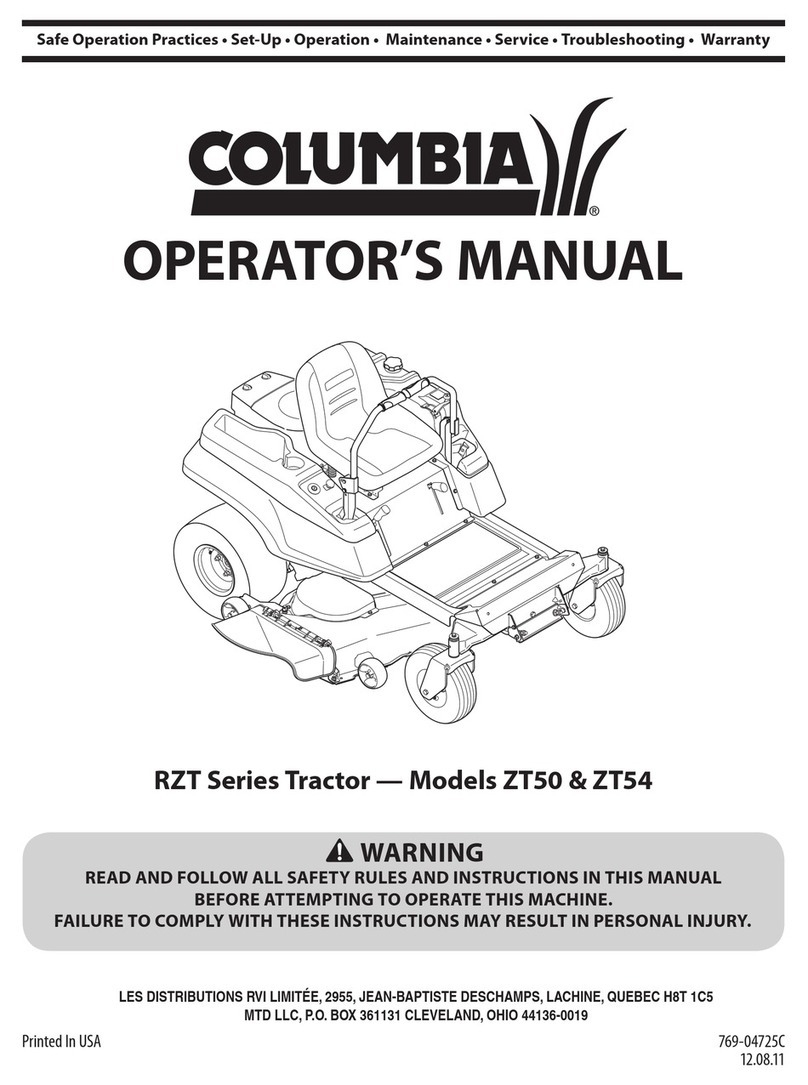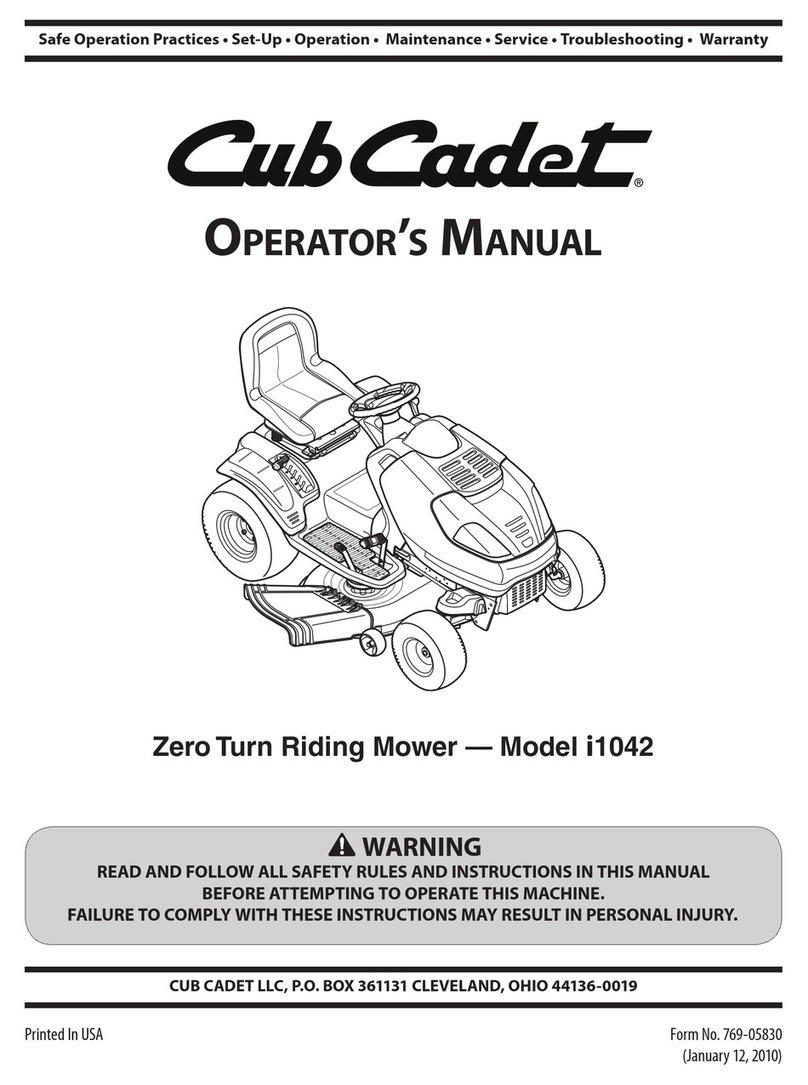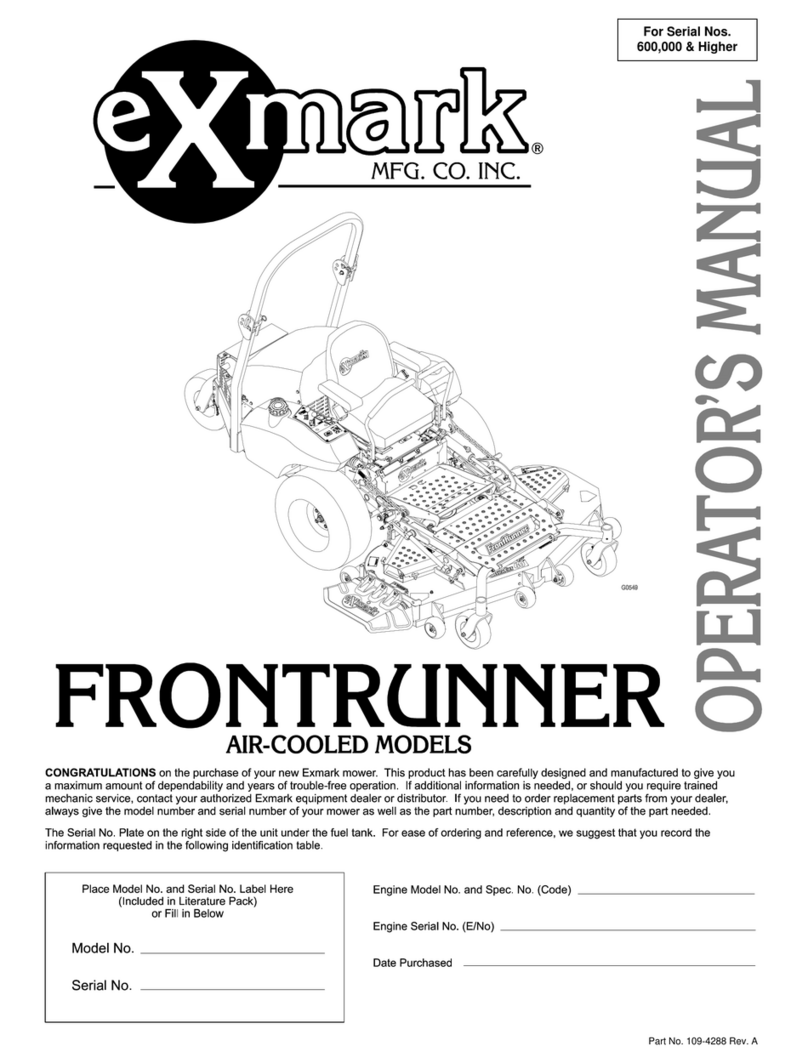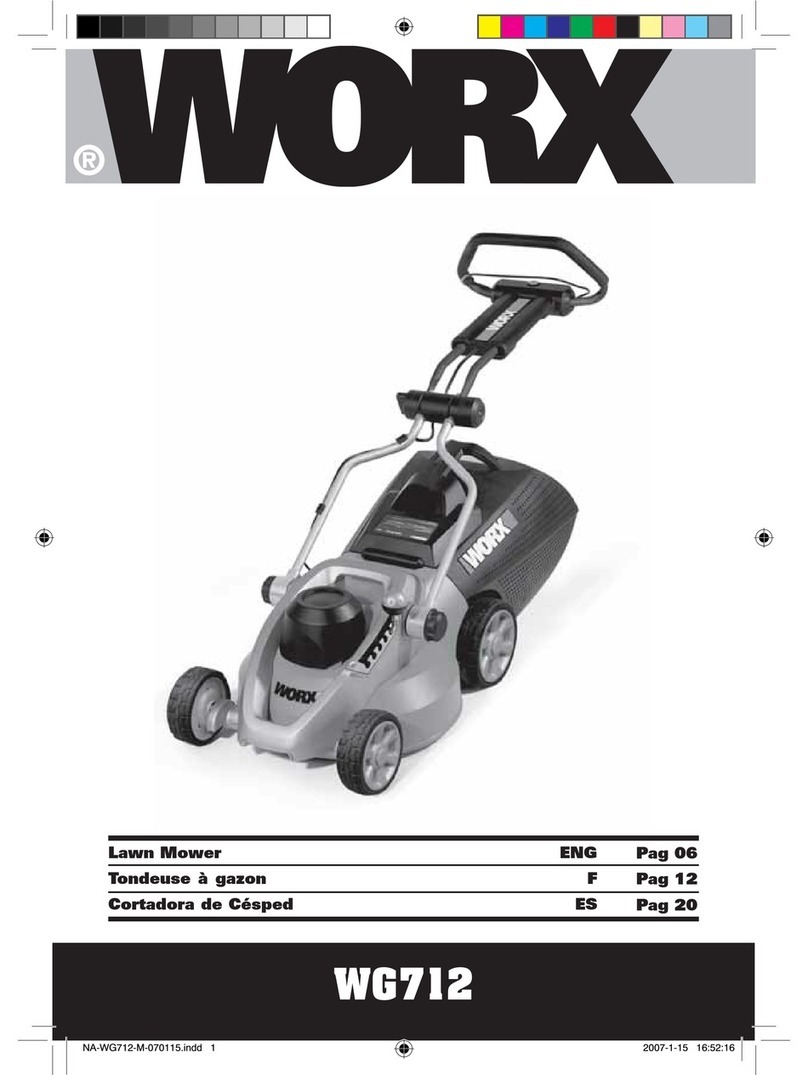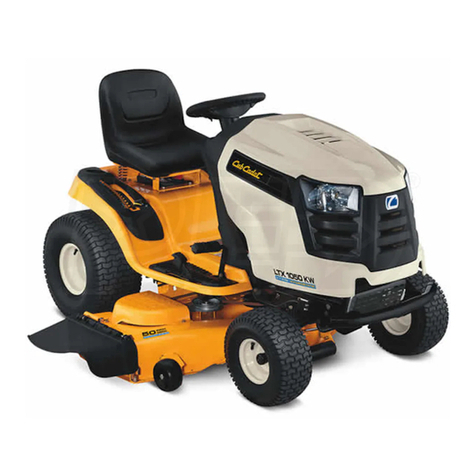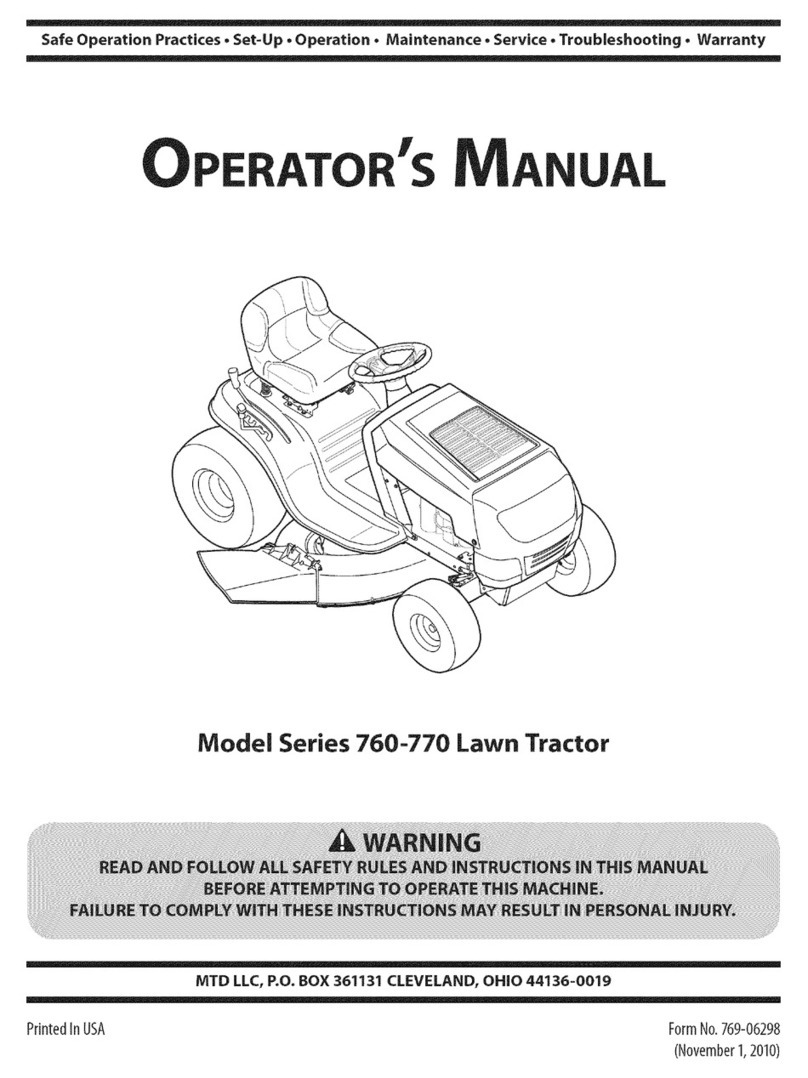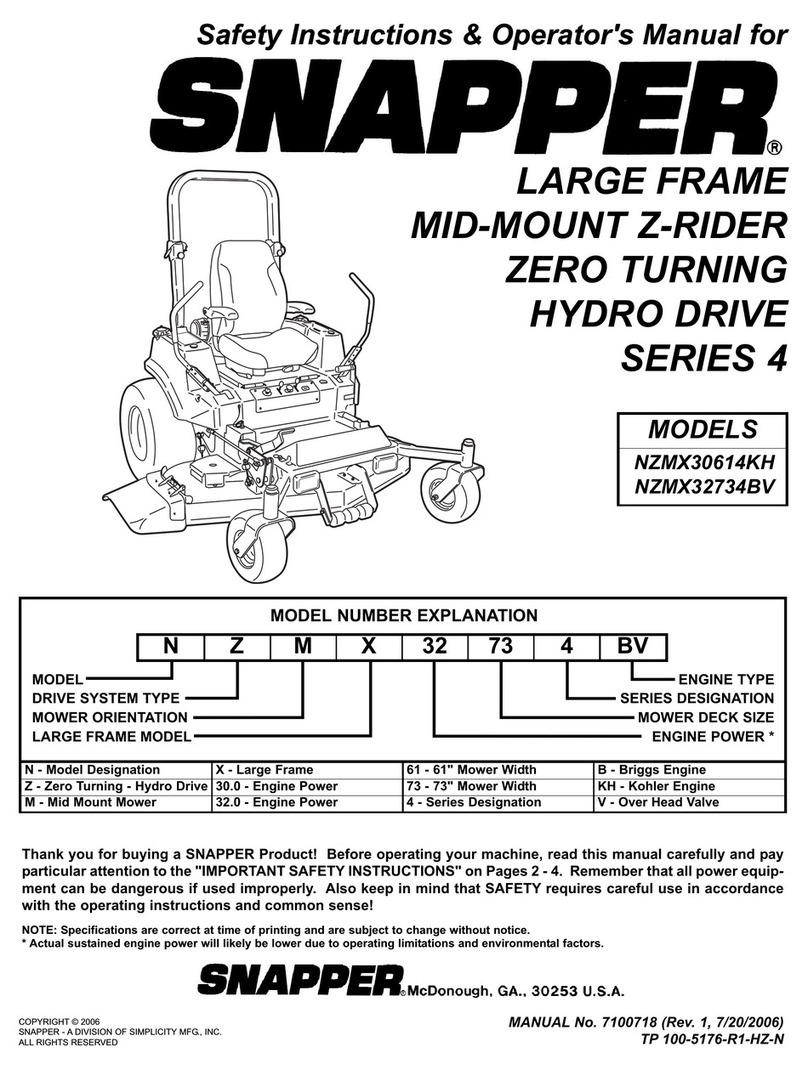EverRide WASP EGWKA1332S User manual

Owner/Operator Manual
Manuel Du Propriétaire/Utilisateur
Models
988410 - EGWKA1332S
988411 - EGWKA1336S
988412 - EGWKA1548S
WASP
03823902 1/09
Printed in USA
ENGLISH
FRANÇAIS

GB - 2
Safety . . . . . . . . . . . . . . . . . . . . . . . . . . . . . . . . . . . . . . 3
Assembly . . . . . . . . . . . . . . . . . . . . . . . . . . . . . . . . . . . 9
Controls and Features. . . . . . . . . . . . . . . . . . . . . . . . 10
Operation . . . . . . . . . . . . . . . . . . . . . . . . . . . . . . . . . . 11
Maintenance Schedule . . . . . . . . . . . . . . . . . . . . . . . 17
Service and Adjustments . . . . . . . . . . . . . . . . . . . . . 18
Storage. . . . . . . . . . . . . . . . . . . . . . . . . . . . . . . . . . . . 26
Troubleshooting . . . . . . . . . . . . . . . . . . . . . . . . . . . . 27
Specifications . . . . . . . . . . . . . . . . . . . . . . . . . . . . . . 28
Warranty . . . . . . . . . . . . . . . . . . . . . . . . . . . . . . . . . . 30
NON-ENGLISH MANUALS
Manuals in languages other than English may
be obtained from your Dealer. Visit your dealer
or www.ariens.com for a list of languages
available for your equipment.
Manuals printed in languages other than English
are also available as a free download on our
website:
www.everride.com
Manuales en idiomas diferentes del ingles
Puede obtener manuales en idiomas diferentes
del inglés en su distribuidor. Visite a su
distribuidor o vaya a www.ariens.com para
obtener una lista de idiomas disponibles para su
equipo.
También puede imprimir manuales en idiomas
diferentes del inglés descargándolos
gratuitamente de nuestra página Web:
www.everride.com
Manuels non anglais
Des manuels dans différentes langues sont
disponibles chez votre revendeur. Rendez-vous
chez votre revendeur ou allez sur le site
www.ariens.com pour consulter la liste des
langues disponibles pour votre équipement.
Les manuels imprimés dans des langues
différentes de l’anglais sont également
disponibles en téléchargement gratuit sur notre site Web :
www.everride.com
THE MANUAL
Before operation of unit, carefully and completely read your
manuals. The contents will provide you with an
understanding of safety instructions and controls during
normal operation and maintenance.
All reference to left, right, front, or rear are given from
operator standing in operation position and facing the
direction of forward travel.
MODEL AND SERIAL NUMBERS
When ordering replacement parts or making service
inquiries, know the Model and Serial numbers of your unit
and engine.
Numbers are located on the product registration form in the
unit literature package. They are printed on a serial number
label, located on the frame of your unit.
• Record Unit Model and Serial numbers here.
• Record Engine Model and Serial numbers here.
TABLE OF CONTENTS
INTRODUCTION
Unit Serial
Number Label
Figure 1
Engine Serial
Number Label
© Copyright 2009 Ariens Company

GB - 3
PRODUCT REGISTRATION
The dealer must register the product at the time of purchase.
Registering the product will help the company process
warranty claims or contact you with the latest service
information. All claims meeting requirements during the
limited warranty period will be honored, whether or not the
product registration card is returned. Keep a proof of
purchase if you do not register your unit.
UNAUTHORIZED REPLACEMENT PARTS
Use only EverRide replacement parts. The replacement of
any part on this vehicle with anything other than an EverRide
authorized replacement part may adversely affect the
performance, durability, or safety of this unit and may void
the warranty. EverRide disclaims liability for any claims or
damages, whether warranty, property damage, personal
injury or death arising out of the use of unauthorized
replacement parts. To locate your nearest EverRide Dealer,
go to www.EverRide.com on the internet.
DISCLAIMER
EverRide reserves the right to discontinue, make changes
to, and add improvements upon its products at any time
without public notice or obligation.The descriptions and
specifications contained in this manual were in effect at
printing. Equipment described within this manual may be
optional. Some illustrations may not be applicable to your
unit.
DEALER DELIVERY
Dealer should:
1. Check all controls for proper function.
2. Check the safety interlock system to make sure that it
is functioning properly. (See Check Safety Interlock
System on page 11.)
3. Fill out Original Purchaser Registration Card and
return the card to EverRide.
4. Explain Limited Warranty Policy.
5. Explain recommended lubrication and maintenance.
Advise customer on adjustments.
6. Instruct customer on controls and operation of unit.
Discuss and emphasize the Safety Precautions. Give
customer Owner/Operator, Parts, and Engine
Manuals. Advise customer to thoroughly read and
understand them.
SAFETY ALERTS
Look for these symbols to point out important
safety precautions. They mean:
Attention!
Personal Safety Is Involved!
Become Alert!
Obey The Message!
The safety alert symbols above and signal words below are
used on decals and in this manual.
Read and understand all safety messages.
SAFETY
WARNING: This cutting machine is capable
of amputating hands and feet and throwing
objects. Failure to observe the safety
instructions in the manuals and on decals
could result in serious injury or death.
Slopes are a major factor related to
loss-of-control and tip-over accidents.
Operation on all slopes requires extra
caution.
Tragic accidents can occur if the operator is
not alert to the presence of children. Never
assume that children will remain where you
last saw them.
Gasoline is extremely flammable and the
vapors are explosive, handle with care.
Disengage attachment, stop unit and engine,
remove key, engage parking brake, and allow
moving parts to stop before leaving
operator’s position.
DANGER: IMMINENTLY HAZARDOUS
SITUATION! If not avoided, WILL RESULT
in death or serious injury.
WARNING: POTENTIALLY HAZARDOUS
SITUATION! If not avoided, COULD
RESULT in death or serious injury.
CAUTION: POTENTIALLY HAZARDOUS
SITUATION! If not avoided, MAY RESULT in
minor or moderate injury. It may also be
used to alert against unsafe practices.

GB - 4
NOTATIONS
NOTE: General reference information for proper operation
and maintenance practices.
IMPORTANT: Specific procedures or information required to
prevent damage to unit or attachment.
PRACTICES AND LAWS
Practice usual and customary safe working precautions, for
the benefit of yourself and others. Understand and follow all
safety messages. Be alert to unsafe conditions and the
possibility of minor, moderate, or serious injury or death.
Learn applicable rules and laws in your area, including those
that may restrict the age of the operator.
REQUIRED OPERATOR TRAINING
Original purchaser of this unit was instructed by the seller on
safe and proper operation. If unit is to be used by someone
other than original purchaser; loaned, rented or sold,
ALWAYS provide this manual and any needed safety
training before operation.
SAFETY DECALS AND LOCATIONS
ALWAYS replace missing or damaged Safety Decals. Refer
to figure below for Safety Decal locations.
1. Danger! To avoid serious injury or death
2. Danger! Rotating Blades
Figure 2
4
3
1
OG1491
2
Read the operator’s manual.
Keep children and others away from unit
while operating.
Never direct discharge toward other people.
Thrown objects can cause injury.
• Keepsafety devices (guards, shields, switches, etc.)
in place and working.
• Check interlock system per manual before use.
• Never allow operation by untrained persons.
• When parking on a slope always chock or block the
wheels.
• Disengage PTO, stop unit and engine, set parking
brake and remove key before making any
inspections, repairs, etc.
ROTATING BLADE! Keep hands and feet
away.
Always stand clear of discharge area. DO NOT
direct discharge toward other people. Remove
objects that could be thrown by the blade. DO
NOT operate mower over gravel and hard
surfaces.
Keep people and pets away when operating
unit. Keep children out of the work area and
under the watchful care of a responsible adult.
Shut off engine, remove key, read manual
before you unplug, adjust or repair unit.
NO STEP! Always keep feet away from
rotating parts.
OL1801
OL4370
OL0910
OL3030
OL0910
OL4370
OL4010
OL4420

GB - 5
3. Warning!
(
4. Danger!
SAFETY RULES
Operator Training Required
• Read the operator’s manual and other training
material. If the operator or mechanic cannot read
English, it is the owner’s responsibility to explain this
material to them. This publication is available in other
languages.
• Become familiar with the safe operation of the
equipment, operator controls, and safety signs.
• All operators and mechanics should be trained. The
owner of the machine is responsible for training the
users.
• Never let children or untrained people operate or
service the equipment. Local regulations may restrict
the age of the operator.
• The owner/user can prevent and is responsible for
accidents or injuries occurring to themselves, other
people, or property.
• Operate the machine in an open, unobstructed area
under the direction of an experienced operator.
Preparation
• Evaluate the terrain to determine what accessories
and attachments are needed to properly and safely
perform the job. Only use accessories and
attachments approved by the manufacturer.
• Wear appropriate clothing including hard hat, safety
glasses and hearing protection. Long hair, loose
clothing or jewelry may get tangled in moving parts.
• Inspect the area where the equipment is to be used
and remove all objects such as rocks, toys and wire
which can be thrown by the machine.
• Use extra care when handling gasoline and other fuels.
They are flammable and vapors are explosive.
a. Use only an approved container.
b. Never remove gas cap or add fuel when engine is
running. Do not smoke.
c. Never refuel or drain the machine indoors.
• Check that the operator’s presence controls, safety
switches and shields are attached and functioning
properly. Do not operate unless they are functioning
properly.
Operating Safely
• Never run an engine in an enclosed area where
dangerous carbon monoxide fumes can collect.
• Only operate in good light, keeping away from holes
and hidden hazards.
• Be sure all drives are in neutral and parking brake is
engaged before starting engine. Only start engine from
the operator’s position.
• Be sure of your footing while using
pedestrian-controlled equipment, especially when
backing up. Walk, don’t run. Never operate on wet
grass. Reduced footing could cause slipping.
• Slow down and use extra care on hillsides. Be sure to
travel in the recommended direction on hillsides. For
this machine, drive across hillsides, not up and down.
Turf conditions can affect the machine’s stability. Use
caution while operating near drop-offs.
• Slow down and use caution when making turns and
when changing directions on slopes.
• Never raise deck with the blades running.
• Never operate with guards not securely in place. Be
sure all interlocks are attached, adjusted properly, and
functioning properly.
• Never operate with the discharge deflector raised,
removed or altered, unless using a grasscatcher. Do
not operate mower without discharge chute or entire
grasscatcher in place.
• Do not change the engine governor setting or
overspeed the engine. Operating the engine at
excessive speed can increase the hazard of personal
injury.
• Stop on level ground, lower implements, disengage
drives, engage parking brake, and shut off engine
before leaving the operator’s position for any reason
including emptying the grasscatchers or unclogging
the chute.
• Stop equipment and inspect blades after striking
objects or if an abnormal vibration occurs. Make
necessary repairs before resuming operations.
• Keep hands and feet away from the cutting units.
• Look behind and down before backing up to be sure of
a clear path.
• Never carry passengers and keep pets and bystanders
away.
• Slow down and use caution when making turns and
crossing roads and sidewalks. Stop blades if not
mowing. Watch for traffic when operating near or
crossing roadways.
Always stand clear of discharge.
DO NOT operate mower unless guards are in
operating position or bagger is attached.
Stay clear of rotating parts.
OL0910
OL3320
OL5100

GB - 6
• Be aware of the mower discharge direction and do not
point it at anyone.
• Do not operate the machine while under the influence
of alcohol or drugs.
• Use care when loading or unloading the machine into
or off of a trailer or truck.
• Use care when approaching blind corners, shrubs,
trees, or other objects that may obscure vision.
• Inspect machine before you operate. Be sure
hardware is tight. Repair or replace damaged, badly
worn, or missing parts. Be sure guards and shields are
in good condition and fastened in place. Make any
necessary adjustments before you operate.
• Before using, always visually inspect to see that the
blades, blade bolts and the mower assembly are not
worn and damaged. Replace worn and damaged
blades and bolts in sets to preserve balance.
• Keep safety labels visible when installing accessories
and attachments.
• Do not wear radio or music headphones. Safe service
and operation require your full attention.
• When machine is left unattended, stored, or parked,
lower the mower deck unless a positive mechanical
lock is used.
• Be sure all drives are in neutral and parking brake is
locked before starting engine. Stand as far away from
the discharge chute as possible with feet well away
from the underside of the deck to start machine.
• Do not hang or secure any item to the control console.
The operator’s station should always remain
unobstructed.
• Do not pull mower backwards while the blades are
rotating. Use the reverse gear to move the machine in
reverse.
Using a Spark Arrestor
The engine in this machine is not equipped with a spark
arrestor muffler. It is a violation of California Public Resource
Code Section 4442 to use or operate this engine on or near
any forest-covered, brush-covered or grass-covered land
unless the exhaust system is equipped with a spark arrestor
meeting any applicable local or state laws. Other states or
federal areas may have similar laws.
A spark arrestor for your machine may be available from
your authorized dealer. An installed spark arrestor must be
maintained in good working order by the operator.
Checking Mowing Area
•Clear mowing area of objects that might be
thrown. Keep people and pets out of mowing area.
•Low-hanging branches and similar obstacles can
injure the operator or interfere with mowing operation.
Before mowing, identify potential obstacles such as
low-hanging branches, and trim or remove those
obstacles.
• Study mowing area. Set up a safe mowing pattern. Do
not mow where traction or stability is doubtful.
Parking Safely
1. Stop machine on a level surface, not on a slope.
2. Disengage mower blades.
3. Lock the park brake.
4. Stop the engine.
5. Remove the key.
6. Wait for engine and all moving parts to stop before you
leave the operator’s station.
7. Close fuel shut-off valve, if your machine is equipped.
8. Remove the spark plug wire (for gasoline engines)
before servicing the machine.
Operating Safely on Slopes
• Slopes are a major factor related to slip and fall
accidents which can result in severe injury. Operation
on all slopes requires extra caution. If you feel uneasy
on a slope, do not mow it.
• Mow across the face of slope, never up and down. Use
extreme caution when changing direction on slopes.
• Keep all movement on slopes slow and gradual. Do
not make sudden changes in speed or direction.
• Watch for holes, ruts, bumps, rocks or other hidden
objects. Uneven terrain could cause a slip and fall
accident. Tall grass can hide obstacles.
• Do not mow on wet grass or excessively steep slopes.
Poor footing could cause a slip and fall accident.
• Do not mow near drop-offs, ditches, embankments, as
well as ponds and other bodies of water. The operator
could lose footing or balance. The machine could
suddenly turn over if a wheel is over the edge of a cliff
or ditch, or if an edge caves in.
• Follow the manufacturer’s recommendations for
counterweights for added stability when operating on
slopes. Remove weights when not required.
• Use extra care with grasscatchers. These can change
the stability of the machine. Do not use grasscatcher
on steep slopes.
Rotating Blades are Dangerous
HELP PREVENT SERIOUS OR FATAL ACCIDENTS:
• Rotating blades can cut off arms and legs, and throw
objects. Failure to observe safety instructions could
result in serious injury or death.

GB - 7
• Keep hands, feet and clothing away from mower deck
when engine is running.
• Be alert at all times, drive forward carefully. People,
especially children can move quickly into the mowing
area before you know it.
• Before backing up, stop mower blades or attachments
and look down and behind the machine carefully,
especially for children.
• Do not mow in reverse.
• Shut off blades when you are not mowing.
• Park machine safely before leaving the operator’s
station for any reason including emptying the catchers
or unplugging the chute.
Rotating Blades are Dangerous -
Protect Children and Prevent
Accidents
Protect Children:
•Tragic accidents can occur if the
operator is not alert to the presence of children.
Children are often attracted to lawn-mowing machines
and mowing activity. Stay alert to the presence of
children. Never assume that children will remain where
you last saw them.
• Keep children indoors, out of the mowing area, and in
the watchful eye of a responsible adult, other than the
operator, when a mower is being operated.
• Be alert and turn mower off if a child enters the work
area. They don’t understand the dangers of rotating
blades or the fact that the operator is unaware of their
presence.
• Never allow a child or an untrained person to operate
the machine.
• Use extra care when approaching blind corners,
shrubs, trees, or other objects that may block your
view of a child.
Checking Wheel Hardware
• A serious accident could occur causing serious injury if
wheel hardware is not tight.
• Check wheel hardware tightness often during the first
100 hours of operation.
• Wheel hardware must be tightened to specified torque
using the proper procedure anytime it is loosened.
Wear Appropriate Clothing
• Always wear safety goggles, or safety glasses with
side shields, and a hard hat when operating the
machine.
• Wear close fitting clothing and safety equipment
appropriate for the job.
• While mowing, always wear substantial footwear and
long trousers. Do not operate the equipment when
barefoot or wearing open sandals.
• Wear a suitable protective device such as earplugs.
Loud noise can cause impairment or loss of hearing.
Maintenance and Storage
•Never operate machine in a closed
area where dangerous carbon monoxide
fumes can collect.
•Disengage drives, lower implement,
lock parking brake, stop engine and
remove key ordisconnect spark plug (for
gas engines). Wait for all movement to stop before
adjusting, cleaning or repairing.
• Clean grass and debris from cutting units, drives,
mufflers, and engine to help prevent fires. Clean up oil
or fuel spillage.
• Let engine cool before storing and do not store near
flame.
• Shut off fuel while storing or transporting. Do not store
fuel near flames or drain indoors.
• Park machine on level ground. Never allow untrained
personnel to service machine. Understand service
procedure before doing work.
• Use jack stands or lock service latches to support
components when required. Securely support any
machine elements that must be raised for service
work.
• Before servicing machine or attachment, carefully
release pressure from any components with stored
energy, such as hydraulic components or springs.
• Release hydraulic pressure by lowering attachment or
cutting units to the ground or to a mechanical stop and
move hydraulic control levers back and forth.
• Disconnect battery or remove spark plug (for gas
engines) before making any repairs. Disconnect the
negative terminal first and the positive last. Reconnect
positive first and negative last.
• Use care when checking blades. Wrap the blades or
wear gloves, and use caution when servicing them.
Only replace blades. Never straighten or weld them.
• Keep hands, feet, clothing, jewelry and long hair away
from moving parts. If possible, do not make
adjustments with the engine running.
• Charge batteries in an open well ventilated area, away
from spark and flames. Unplug charger before
connecting or disconnecting from battery. Wear
protective clothing and use insulated tools.

GB - 8
• Keep all parts in good working condition and all
hardware tightened. Replace all worn or damaged
decals.
• Check grasscatcher components and the discharge
guard frequently and replace with manufacturer’s
recommended parts, when necessary. Grasscatcher
components are subject to wear, damage, and
deterioration which could expose moving parts or allow
objects to be thrown.
• Keep all nuts and bolts tight, especially blade
attachment bolts, to be sure the equipment is in safe
working condition.
• Check brake operation frequently. Adjust and service
as required.
• On multi-bladed machines, take care as rotating one
blade can cause other blades to rotate.
Avoid High Pressure Fluids
• Hydraulic hoses and lines can fail due to physical
damage, kinks, age, and exposure. Check hoses and
lines regularly. Replace damaged hoses and lines.
• Hydraulic fluid connections can loosen due to physical
damage and vibration. Check connections regularly.
Tighten loose connections.
• Escaping fluid under pressure can penetrate the skin
causing serious injury. Avoid the hazard by relieving
pressure before disconnecting hydraulic or other lines.
Tighten all connections before applying pressure.
• Search for leaks with a piece of cardboard. Protect
hands and body from high pressure fluids.
• If an accident occurs, see a doctor immediately. Any
fluid injected into the skin must be surgically removed
within a few hours or gangrene may result. Doctors
unfamiliar with this type of injury should reference a
knowledgeable medical source.
Prevent Fires
• Machine fires and structure fires can occur if a
machine is stored before allowing it to cool, or if debris
is not removed from around the engine and muffler, or
if stored near combustible materials.
• Remove grass and debris from engine compartment
and muffler area, before and after operating machine,
especially after mowing or mulching in dry conditions.
• Empty the grasscatcher completely before storing.
Always shut off fuel when storing or transporting
machine, if the machine has a fuel shutoff.
• Do not store machine near an open flame or source of
ignition, such as a water heater or furnace.
• Check fuel lines, tank, cap, and fittings frequently for
cracks or leaks. Replace if necessary.
Tire Safety
Explosive separation of a tire and rim parts can cause
serious injury or death:
• Do not attempt to mount a tire without the proper
equipment and experience to perform the job.
• Always maintain the correct tire pressure. Do not
inflate the tires above the recommended pressure.
Never weld or heat a wheel and tire assembly. The
heat can cause an increase in air pressure resulting in
a tire explosion. Welding can structurally weaken or
deform the wheel.
• When inflating tires, use a clip-on chuck and extension
hose long enough to allow you to stand to one side and
NOT in front of or over the tire assembly.
• Check tires for low pressure, cuts, bubbles, damaged
rims or missing lug bolts and nuts.
Handling Fuel Safely
To avoid personal injury or
propertydamage, useextreme
care in handling fuel. Fuel is
extremely flammable and fuel
vapors are explosive:
•Extinguish all cigarettes, cigars,
pipes, and other sources of ignition.
•Use only an approved fuel
container. Use only non-metal,
portable fuel containers approved
by the Underwriter’s Laboratory
(U.L.) or the American Society for
Testing & Materials (ASTM). If using a funnel, make
sure it is plastic and has no screen or filter.
• Never remove the fuel tank cap or add fuel with the
engine running. Allow engine to cool before refueling.
• Never add fuel to or drain fuel from the machine
indoors. Move machine outdoors and provide
adequate ventilation.
• Clean up spilled fuel immediately. If fuel is spilled on
clothing, change clothing immediately. If fuel is spilled
near machine, do not attempt to start the engine but
move the machine away from the area of spillage.
Avoid creating any source of ignition until fuel vapors
have dissipated.

GB - 9
• Never store the machine or fuel container where there
is an open flame, spark, or pilot light such as on a
water heater or other appliance.
• Prevent fire and explosion caused by static electric
discharge. Static electric discharge can ignite fuel
vapors in an ungrounded fuel container.
• Never fill containers inside a vehicle or on a truck or
trailer bed with a plastic liner. Always place containers
on the ground away from your vehicle before fueling.
• Remove fuel-powered equipment from the truck or
trailer and refuel it on the ground. If this is not possible,
then refuel such equipment with a portable container,
rather than from a fuel dispenser nozzle.
• Keep the nozzle in contact with the rim of the fuel tank
or container opening at all times until the fueling is
complete. Do not use a nozzle lock-open device.
• Never overfill fuel tank. Replace fuel tank cap and
tighten securely.
• Replace all fuel container caps securely after use.
• For gasoline engines, do not use gas with methanol.
Methanol is harmful to your health and to the
environment.
Handling Waste Product and Chemicals
Waste products, such as, used oil, fuel, coolant, brake fluid,
and batteries, can harm the environment and people:
• Do not use beverage containers for waste fluids -
someone may drink from them.
• See your local Recycling Center or authorized dealer
to learn how to recycle or get rid of waste products.
• A Material Safety Data Sheet (MSDS) provides
specific details on chemical products: physical and
health hazards, safety procedures, and emergency
response techniques. The seller of the chemical
products used with your machine is responsible for
providing the MSDS for that product.
1. Remove the unit from shipping container.
2. Adjust tire pressure to 55 to 110 kPa (8 to 16 psi).
3. Check the adjustments outlined in Service &
Adjustments.
4. Check engine oil level. See engine manual.
5. Add clean fuel to the fuel tank. See engine manual for
type and grade.
6. Check for loose hardware.
7. Be sure that safety interlock system operates correctly.
See Check Safety Interlock System on page 11.
8. Be sure that unit tracks straight.
Unit must not pull sharply to the left or right when the
steering levers are released. See TRACKING
ADJUSTMENT on page 18.
ASSEMBLY
WARNING: AVOID INJURY. Read and
understand the entire Safety section before
proceeding.
CAUTION: Avoid injury! Explosive separation of
tire and rim parts is possible when they are
serviced incorrectly:
• Do not attempt to mount a tire without the
proper equipment and experience to perform
the job.
• Do not inflate the tires above the
recommended pressure.
• Do not weld or heat a wheel and tire
assembly. Heat can cause an increase in air
pressure resulting in an explosion. Welding
can structurally weaken or deform the wheel.
• Do not stand in front or over the tire
assembly when inflating. Use a clip-on chuck
and extension hose long enough to allow you
to stand to one side.

GB - 10
1. Shift Lever
2. Steering Lever Latches
3. Steering Levers
4. Throttle Lever
5. Ignition Switch
6. PTO Switch
7. Operator Presence Controls
8. Fuel Cap
9. Recoil Starter Handle
10. Traction Belt Guard
11. Choke Control
CONTROLS AND FEATURES
Figure 3
1
2
2
3
3
77
46
5
11
8
9
10

GB - 11
CONTROLS AND FEATURES
See Figure 3 for controls and features locations.
SAFETY INTERLOCK SYSTEM
Check Safety Interlock System
Test the safety interlock system at each operation. If the
system does not function properly, do not operate the unit
until repairs are made.
The engine will only start with the PTO disengaged. The shift
lever must be in neutral for engine to start.
Engine must not start unless PTO is disengaged and the
shift lever is in neutral. To test:
1. With engine off, engage PTO.
2. Turn ignition switch to On. Pull recoil start handle.
Engine must not start.
3. Disengage PTO.
The engine MUST stop whenever the operator removes
both hands from controls while the PTO or transmission is
engaged. To test:
1. Start engine and engage PTO.
2. Release operator presence control lever(s). Engine
must stop.
3. Disengage PTO.
4. Restart engine.
5. Place shift lever in Forward.
6. Release operator presence control lever. Engine must
stop.
Operator Presence Control
The operator presence control lever must be pressed to
operate the PTO or traction drive. When the shift lever or
PTO is engaged, releasing the operator presence control
lever stops the engine.
Steering Levers
The steering levers are used to steer, operate in forward and
reverse, and stop the unit. When held against the handlebar,
the brakes are engaged.
Steering Lever Latches
The steering lever latches hold the steering levers in the
neutral position and keep the brakes applied.
Ignition Switch
Operate the ignition switch with the removable
key. The switch uses two positions: Off (1) and
On (2). To start the engine, turn the key to On
(2) and pull the recoil handle. To stop the
engine, turn the key to Off (1).
Throttle Lever
The throttle lever changes the speed of the
engine. Move the throttle lever to Fast (1) to
increase engine speed. Move the lever to Slow
(2) to decrease engine speed.
Choke Control
Use the choke control to start a cold engine. Pull
the control out to choke the engine. Push the
control in when the engine gets warm.
OPERATION
WARNING: AVOID INJURY. Read and
understand the entire Safety section before
proceeding.
DANGER: SAFETY INTERLOCK SYSTEM
FAILURE and improper operation of unit can
result in death or serious injury. ALWAYS know
the safety interlock system is operating
properly. See Check Safety Interlock System on
page 11 for testing instructions.
CAUTION: AVOID INJURY. Operate only when
operator presence control is functioning
correctly. See Check Safety Interlock System on
page 11 for testing instructions.
WARNING: AVOID INJURY. When the engine is
running and the shift lever is engaged, releasing
only one steering latch causes the unit to circle
around one drive wheel.
ALWAYS hold both steering levers against the
handlebar when releasing the steering lever
latches.
ALWAYS release levers slowly.
OF1212
OG1180
1
2
OG1190

GB - 12
Shift Lever
The shift lever sets the direction and speed of the unit.
R = reverse
N = neutral
1 = the slowest forward speed
5 = the fastest forward speed.
PTO Clutch Pull the PTO (power take off) switch On (1) to
engage the mower blades. Push the PTO
switch Off (2) to disengage the mower
blades.
Recoil Starter Handle
Pull the recoil starter handle to start the engine.
FILL FUEL TANK
Using Proper Fuel
Use regular grade unleaded fuel with an octane rating of 87
octane or higher. Fuel blends containing up to 10% ethanol
or up to 15% MTBE reformulated fuel are acceptable. Do not
use fuel or additives containing methanol as engine damage
can occur.
Always use fresh, clean fuel that is purchased in a quantity
that can be used within approximately 30 days, or add fuel
stabilizer.
Fuel is blended to give best seasonal performance. To avoid
engine performance problems such as hard starting or vapor
lock, use in-season fuel. Use fuel during warm weather that
was purchased during that season, and use fuel during cold
weather that was purchased during that season.
Fuel can become stale in machines with engines that are
used seasonally or infrequently during a season. Stale fuel
can produce varnish and plug carburetor components which
can affect engine performance.
Keep fuel storage container tightly covered and in a cool
area out of direct sunlight. Fuel can break down and
degrade if not sealed properly or exposed to sun and heat.
Condensation may collect in the fuel tank because of a
variety of operating or environmental conditions and, over
time, may affect your machine’s operation. Fill fuel tank at
the end of daily use and store fuel in plastic containers to
reduce condensation.
For best year-round performance and fuel-handling, add
stabilizer to fuel immediately after fuel purchase. Such
practice helps prevent engine performance problems and
allows fuel storage in the machine all year without draining.
To add fuel to the fuel tank:
1. Put the unit in an open area.
2. Stop the engine.
3. Allow engine to cool.
4. Clean the fuel cap and the area around the fuel cap to
prevent dirt from entering the fuel tank.
5. Remove the cap from the fuel tank.
6. Fill the fuel tank. Be careful not to spill.
7. Install the cap on the fuel tank and tighten.
8. Clean up any spilled fuel before starting the engine.
TO STOP IN AN EMERGENCY
1. Release operator presence control(s).
2. Turn the ignition key Off.
3. Allow engine to stop completely.
4. Lock steering levers in neutral.
STARTING AND SHUT OFF
Before Each Use
Check each item in Each Use in the Maintenance Schedule.
NOTE: The engine will not start unless the shift lever is in
neutral, and the Power Take Off (PTO) is Off.
Recoil Start
1. Lock the steering lever latches in neutral.
2. Put the shift lever in neutral.
3. Move PTO switch to Off.
4. Set throttle to the proper starting position. If the engine
is cold, choke the engine.
5. Turn ignition switch to On.
6. Grasp recoil starter handle and pull rope out slowly
until it pulls harder. This is the compression stroke.
WARNING: Fuel is highly flammable and its
vapors are explosive. Handle with care. Use an
approved fuel container.
NO smoking, NO sparks, NO flames. ALWAYS
allow engine to cool before servicing.
NEVER fill fuel tank when engine is running or
hot from operation.
NEVER fill or drain fuel tank indoors.
Replace fuel cap securely and clean up spilled
fuel.
Figure 4
OE0260
1
2

GB - 13
7. Let the rope rewind slowly.
8. Pull rope with rapid continuous full arm stroke to start
engine. Allow rope to rewind slowly.
IMPORTANT: DO NOT let starter handle snap against
engine.
9. Repeat until engine starts. (If engine does not start,
refer to Engine Manual.)
10. After engine starts, adjust choke as needed. Allow
engine to warm and run smoothly before operating
unit.
Shut Off
1. Lock steering levers in neutral.
2. Shut off the PTO.
3. Move the throttle lever to Slow.
4. Put the shift lever in neutral.
5. Turn the ignition key Off.
6. Allow engine to stop completely.
TO OPERATE UNIT
Operate the unit only in the operator’s position directly
behind the handlebars.
To shift unit:
1. Stop unit movement by pulling both steering levers all
the way up.
2. You can move the shift lever one of two ways:
• Continue to hold up both steering levers and use your
knee to move the shift lever to the desired position.
• Lock both steering levers. Move the shift lever to the
desired position. Hold the steering levers up as you
unlock them.
3. Release both steering levers slowly.
To operate:
1. Start the engine (See STARTING AND SHUT OFF on
page 12).
2. Move the throttle lever to the Fast position.
3. Engage the operator presence control and move shift
lever to desired direction and speed.
4. Hold steering levers against the handlebar and release
steering latch levers.
• To move straight forward; slowly release both steering
levers to the full outward position.
• To stop unit in neutral, hold levers in the neutral
position.
• To lock unit in neutral, engage both steering latches.
• To turn to the left, pull the left hand lever up.
• To turn to the right, pull the right hand lever up.
To move in reverse:
1. Hold the steering levers against the handlebar.
2. Engage steering lever latches.
3. Engage the operator presence control and move shift
lever to Reverse.
4. Release steering levers slowly.
WARNING: AVOID INJURY. When the engine
is running and the speed control lever is
engaged, holding only one steering lever in
neutral causes the unit to circle sharply around
one drive wheel.
WARNING: AVOID INJURY. When the engine
is running and the shift lever is engaged,
releasing only one steering latch causes the
unit to circle around one drive wheel.
ALWAYS hold both steering levers against the
handlebar when releasing the steering lever
latches.
ALWAYS release levers slowly.
WARNING: Uncontrolled reverse travel can
result in serious injury.
Do not put shift lever into the reverse position
unless you are prepared to operate in reverse.
OG1410
OG1420
OG1430
OG1440
OG1450

GB - 14
To mow:
1. Lock steering levers in neutral.
2. Put the shift lever in neutral.
3. Move the throttle lever to the fast position.
4. Engage the operator presence control lever.
NOTE: Operator presence control must remain engaged.
5. Move the PTO switch to On to engage mower.
IMPORTANT: NEVER engage the PTO if the mower is
plugged with grass or other material. This will damage the
PTO belt.
6. Move the shift lever to set a slow ground speed.
7. Hold steering levers against the handlebar and release
the lock latches.
8. Release steering levers slowly.
When you know how to operate the unit, select a speed
appropriate to your mowing conditions.
To stop mowing:
1. Lock the steering levers in neutral.
2. Keep one hand on the operator presence control and
move the shift lever to the neutral position.
3. Move the throttle lever to 1/2 speed.
4. Turn off PTO switch.
CUTTING HEIGHT ADJUSTMENT
NOTE: Adjust the cutting height using a combination of the
deck mounting location on the deck carrier frame, spacers
on the front casters, and spacers between the mower blades
and the deck spindles. The desired cutting height may be set
by adjusting only the blade spacers and caster spacers.
Refer to the cutting height charts below to determine which
combination of deck mounting location, blade spacers and
caster spacers will set the desired cutting height.
1. Shut off the unit. See Shut Off on page 13 and "To stop
mowing."
2. Support the rear of the machine and the back edge of
the mower deck.
3. Remove the six deck mounting bolts (three per side).
4. Align the mounting holes in the deck frame with the
unit frame and re-install the mounting bolts in the
appropriate holes and tighten to 47-54 N•m
(35-40 lb.-ft).
5. Using a suitable lifting device, lift the front of the
machine.
6. Remove lynch pin and spacer bushing.
NOTE: Adjust caster wheel spacers to keep mower deck
tilted slightly down at the front.
7. Adjust caster wheel spacers to set the front cutting
height accordingly.
WARNING: ALWAYS block wheels, engage
parking brake and know all jack stands are
strong, secure and will hold weight of unit
during maintenance.
IMPORTANT: Do not allow washer (item 4 in Figure 6)
to sit on caster yoke (item 5 in Figure 6). It must be on
top of height-of-cut spacer bushings (item 3 in Figure 6).
Top Mounting Holes
Bottom Mounting Holes
Figure 5
1. Lynch Pin
2. Spacer Bushing
3. Spacers
4. Washer
5. Caster Yoke
12
3
4
5
Figure 6

GB - 15
8. Remove the mower blade from the spindle and place
the appropriate number of 1/4" spacers between the
spindle and the blade.
IMPORTANT: DO NOT allow the blade to be less than
3.2mm (1/8 in.) above the lip of the mower deck.
9. Replace mower blade and tighten mounting bolt to
163 N•m (120 lb.-ft.).
10. Remove supports from deck and mower frame.
NOTE: Store the unused 1/4" blade spacers on hex bolts
mounted to the deck:
WARNING: Sharp edges can cut. Moving parts
can cut off fingers or a hand. Wrap blade(s),
wear sturdy gloves and use extreme caution
when servicing. On multi-blade mowers,
rotation of one blade will cause all blades to
rotate.
Store unused 1/4"
blade spacers here
when not in use.
Figure 7
CUTTING HEIGHT CHART – DECK BOLTED TO
FRAME WITH TOP HOLES
Approximate
Cutting Height 1/4" Blade Spacers 1/2" Castor Spacers
cm (Inches) Stored Between
Spindle and
Blade
Below
Weldment Above
Weldment
3.2 (1.25) 0 3 0 6
3.8 (1.5) 1 2 0 6
4.4 (1.75) 2 1 0 6
5.1 (2.0) 3 0 0 6
3.8 (1.5) 0 3 1 5
Recommended
Range for Best
Cut Quality
4.4 (1.75) 1 2 1 5
5.1 (2.0) 2 1 1 5
5.7 (2.25) 3 0 1 5
4.4 (1.75) 0 3 2 4
5.1 (2.0) 1 2 2 4
5.7 (2.25) 2 1 2 4
6.35 (2.5) 3 0 2 4
5.1 (2.0) 0 3 3 3
5.7 (2.25) 1 2 3 3
6.35 (2.5) 2 1 3 3
7.0 (2.75) 3 0 3 3

GB - 16
PARKING
1. Shut off the unit. See Shut Off on page 13 and "To stop
mowing."
2. Remove the key.
3. Lock both steering lever latches in neutral to engage
the brakes.
4. Chock or block the wheels if parked on a slope.
TO PUSH UNIT BY HAND
To move the unit without the engine running:
1. Put the shift lever in neutral.
2. Disengage the lock latches. Release steering levers.
The brake is disengaged when the steering levers are
released.
3. Push unit to desired location.
IMPORTANT: Towing the unit will damage transmission.
TO TRANSPORT UNIT
Transporting Machine on a Trailer
Use a heavy-duty trailer to transport your machine. Trailer
must have signs and lights required by law.
1. Drive machine onto a trailer.
2. Engage brake lever locks.
3. Place transmission in NEUTRAL.
4. Shut engine off.
5. Remove key.
6. Turn fuel shutoff valve to off position.
7. Fasten machine to trailer with heavy-duty straps,
chains or cables. Both front and rear straps must be
directed down and outward from machine.
CUTTING HEIGHT CHART – DECK BOLTED TO
FRAME WITH BOTTOM HOLES
Approximate
Cutting Height 1/4" Blade Spacers 1/2" Castor Spacers
cm (Inches) Stored Between
Spindle and
Blade
Below
Weldment Above
Weldment
7.0 (2.75) 0 3 3 3
7.62 (3.0) 1 2 3 3
8.3 (3.25) 2 1 3 3
8.9 (3.5) 3 0 3 3
7.62 (3.0) 0 3 4 2
8.3 (3.25) 1 2 4 2
Recommended
Range for Best
Cut Quality
8.9 (3.5) 2 1 4 2
9.5 (3.75) 3 0 4 2
8.3 (3.25) 0 3 5 1
8.9 (3.5) 1 2 5 1
9.5 (3.75) 2 1 5 1
10.2 (4.0) 3 0 5 1
8.9 (3.5) 0 3 6 0
9.5 (3.75) 1 2 6 0
10.2 (4.0) 2 1 6 0
10.8 (4.25) 3 0 6 0
CAUTION: Avoid injury! Use extra care when
loading or unloading the machine into a trailer
or truck.
Close fuel shut-off valve, if your machine is
equipped.
IMPORTANT: Avoid damage! Transporting a machine
on a trailer or on a truck bed at high speeds can result in
hood or engine cover raising and possibly coming off
machine if not secured.
• Position machine on trailer so hood or engine
cover opens from rear of trailer to prevent wind
from blowing hood or cover open.
• Secure hood or engine cover with existing
machine locks or latches.
• Secure hood or engine cover with tie down straps
if no locks or latches exist.

GB - 17
*Change oil after first 8 hours of operation and every 100 hours thereafter.
MAINTENANCE SCHEDULE
Period Service Task
Each Use
Check Safety Interlock System WARNING: Safety interlock system failure and improper operation of
unit can result in death or serious injury. Test this system each time
the unit is operated. If this system does not function as described, do
not operate until repairs are made. See Check Safety Interlock
System on page 11.
Check Air Cleaner Check the air cleaner element before each use. See engine manual for
detailed instructions.
Check Engine Oil Check the engine oil level before each use. Never operate the engine when
the oil level is low. See engine manual for detailed instructions.
Check Engine Cooling Check the engine air cooling system before each use. See engine manual for
detailed instructions.
Check Fasteners Check all nuts, bolts, and other fasteners before each use. Replace missing
or damaged fasteners.
Check Tire Pressure Check tires for proper inflation, excessive wear or damage before each use.
The correct air pressure is 55 to 110 kPa (8 to 16 psi).
Follow Engine Manual
Maintenance Schedule Perform scheduled engine maintenance. See engine manual for detailed
instructions.
Every 25
Hours Check All Belts Check all belts for wear or damage. If belts slip, check for damaged belt
tensioner.
Mower Blades Check mower blades for wear. Sharpen or replace as needed. See MOWER
BLADES on page 22.
Clean Air Cleaner Foam
Element See engine manual for detailed instructions.
Every 50
Hours General Lubrication Oil all pivot points and pin connections. Grease lube fittings. See GENERAL
LUBRICATION on page 18.
Every 100
Hours
Change Engine Oil*Open the petcock to drain oil through oil drain hose on the right side of
engine. See engine manual for additional instructions.
Check Fuel Filter See engine manual for detailed instructions.
Check Spark Plug See engine manual for detailed instructions.
Check Muffler Check muffler for damage or wear. Replace if necessary.
Clean Air Cleaner Paper
Element See engine manual for detailed instructions.

GB - 18
GENERAL LUBRICATION
Apply a small amount of oil to the pivot points as required for
smooth operation (Figure 8).
Apply high quality lithium based grease to all lube fittings
every 50 hours of operation.
TRACKING ADJUSTMENT
Check Forward Tracking
1. Start engine and run unit at full throttle.
2. Shift into a forward gear and slowly release both
steering levers to the full outward position.
3. Note to which direction, if any, the unit pulls.
4. Stop unit and engine.
5. Adjust tracking if needed.
Try each of the following steps until the unit tracks straight. It
may not be necessary to perform all the steps.
If unit turns to the right:
1. Reduce the air pressure in the left tire.
2. Increase the air pressure in the right tire.
3. Check for brake binding on right wheel and adjust as
needed.
If unit turns to the left:
1. Reduce the air pressure in the right tire.
2. Increase the air pressure in the left tire.
3. Check for brake binding on left wheel and adjust as
needed.
ADJUST STEERING LEVERS
For each lever:
1. Turn off the engine, remove the key and allow unit to
cool.
2. Release steering or control levers (Figure 9).
3. Shift transmission into neutral. Operate steering or
control lever several times. Do not move unit.
4. Remove the hair pin and disconnect the trunnion from
the wheel clutch weldment.
5. Adjust the trunnion on the steering control rod until the
gap between the ends of the steering lever and
handlebar grip is 7.62 cm – 8.26 cm (3 in. – 3-1/4 in.).
6. Connect trunnion to wheel clutch weldment and secure
with hair pin.
7. Repeat for other steering lever.
SERVICE AND ADJUSTMENTS
WARNING: AVOID INJURY. Read and
understand the entire Safety section before
proceeding.
Figure 8
1. Half Shafts
2. Wheel Bearings
3. Spindle Bearings
4. Caster Pivots
OG1485
2
3
3
1
2
4
NOTE: 32-Inch Deck Shown.
Figure 9
1. Steering Lever
2. Wheel Clutch
Weldment
3. Trunnion
4. Steering Control Rod
5. Hair Pin
7.62 cm – 8.26 cm
1
2
5
4
3
(3 in. – 3-1/4 in.)

GB - 19
ADJUST BRAKES
NOTE: The traction belt must disengage as the brake starts
to engage.
1. Turn off the engine, remove the key and allow unit to
cool.
2. If brakes do not disengage fully when traction belt is
engaged, the brakes are too tight. Disconnect trunnion
from the clutch weldment and turn the trunnion up the
brake rod to reduce braking. Reconnect the trunnion to
the clutch weldment (Figure 10).
3. If brakes do not engage fully when traction belt is
disengaged, the brakes are too loose. Disconnect
trunnion from the clutch weldment and turn the
trunnion down the brake rod to increase braking.
Reconnect the trunnion to the clutch weldment
(Figure 10).
4. Start engine and test in low gear for proper brake
engagement.
REPLACE TRACTION BELTS
1. Turn off the engine, remove the key and allow unit to
cool.
2. Release the steering levers.
3. Raise the rear of the unit so that the drive wheels are
off the ground.
4. Disconnect clutch idler pulley spring (Figure 11).
5. Remove traction belt guard.
6. Remove hair pin and trunnion holding steering control
rod to wheel clutch weldment.
7. While slowly turning the drive wheel, work the traction
belt off the transmission shaft pulley and drive wheel.
8. Install new traction belt.
9. Connect steering control rod to wheel clutch arm
weldment with trunnion and hair pin.
10. Replace traction belt guard.
11. Replace clutch idler pulley spring.
12. Lower the unit.
13. Check steering lever adjustment. See ADJUST
STEERING LEVERS on page 18.
Figure 10
1. Trunnion
2. Wheel Clutch Weldment
3. Brake Rod
1
3
2
WARNING: AVOID INJURY. An extension
spring, when extended, stores energy and
can be dangerous. Always use tools
specifically designed for installing or
removing an extension spring. Always
compress or extend springs slowly.
OG0751
1. Clutch Idler Pulley
Spring
2. Traction Belt Guard
3. Hair Pin
4. Trunnion
5. Steering Control Rod
6. Wheel Clutch
Weldment
7. Traction Belt
8. Transmission Shaft
Pulley
9. Drive Wheel
Figure 11
5
9
1
8
4
3
6
72

GB - 20
ADJUST SHIFT LEVER LINKAGE
IMPORTANT: If the shift lever and the transmission detent
are improperly aligned, the transmission may fail
prematurely. Align the shift lever and detent as carefully as
possible. The .8mm (.030 in.) clearance helps prevent
premature wear of the detent plate and shift lever.
The transmission shift lever is attached to the transmission
shift arm with two 5/16-18 bolts (Figure 13).
To adjust:
1. Stop the engine. Remove ignition key. Put PTO lever in
the "OFF" position. Put the shift lever in neutral.
2. Loosen two 5/16-18 bolts on shift lever.
3. Align the shift lever so it is centered in gear position 2
on the detent plate and is .8mm (.030 in.) from the V
(Figure 14).
NOTE: If the shift lever cannot be adjusted to tolerance with
the shift lever hardware alone, loosen the hardware holding
the detent plate to the frame and adjust the detent plate to
tolerance.
4. Tighten bolts securely.
NOTE: Before starting unit, test the shift lever to make sure
it engages all gear positions.
REPLACE TRANSMISSION BELT
1. Stop the engine. Remove ignition key. Put PTO switch
in the "OFF" position. Put the shift lever in neutral.
2. Remove mower drive belt from mower clutch sheave.
See 32" and 36" BELT REPLACEMENT on page 21 or
48" BELT REPLACEMENT on page 21.
3. Loosen idler pulley mounting bolt and slide idler pulley
away from the belt (Figure 15).
4. Loosen one and remove one engine mounting bolt and
turn the clutch stop away from the clutch. Save the
hardware.
5. Remove old transmission belt from mower clutch
sheave and transmission sheave.
Figure 12
NOTE: Move spring anchor location to hole
to gain more traction on hilly terrain.
Traction Clutch
Spring Anchor
1. Shift Lever
2. 5/16-18 Bolts 3. Transmission
Figure 13
1
2
3
Shift Lever
Figure 14
.8mm (.030 in.)
Loosen hardware and adjust
detent plate, if necessary.
This manual suits for next models
6
Table of contents
Other EverRide Lawn Mower manuals
Popular Lawn Mower manuals by other brands
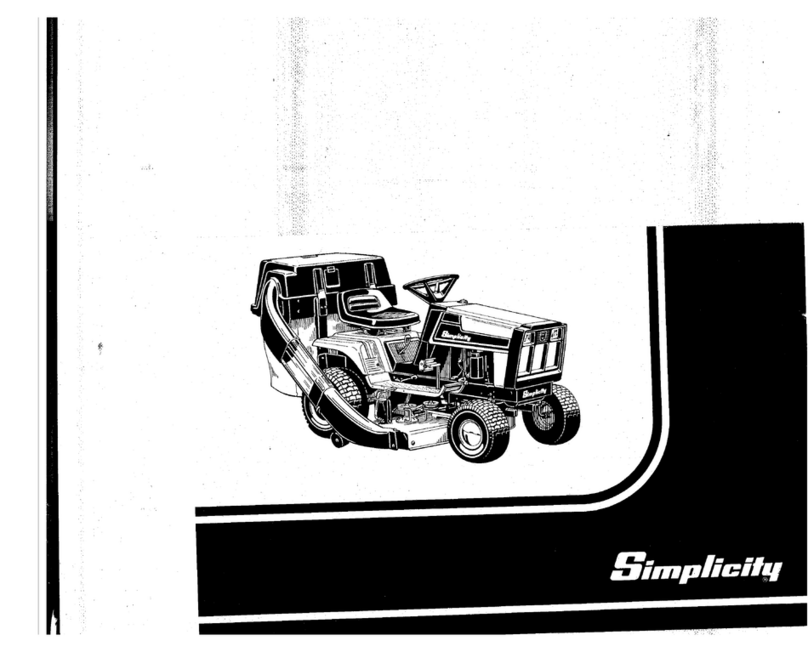
Simplicity
Simplicity 3244 Operator's manual
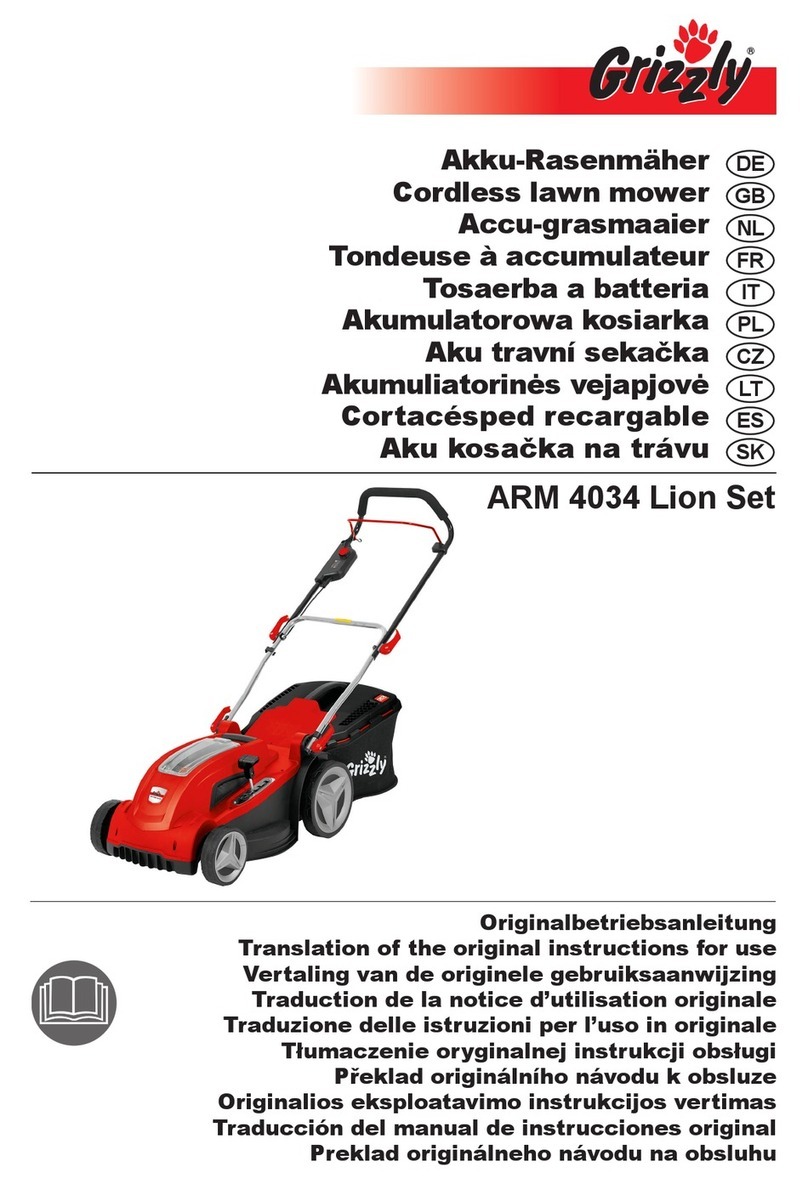
Grizzly
Grizzly ARM 4034 Lion Set Instructions for use
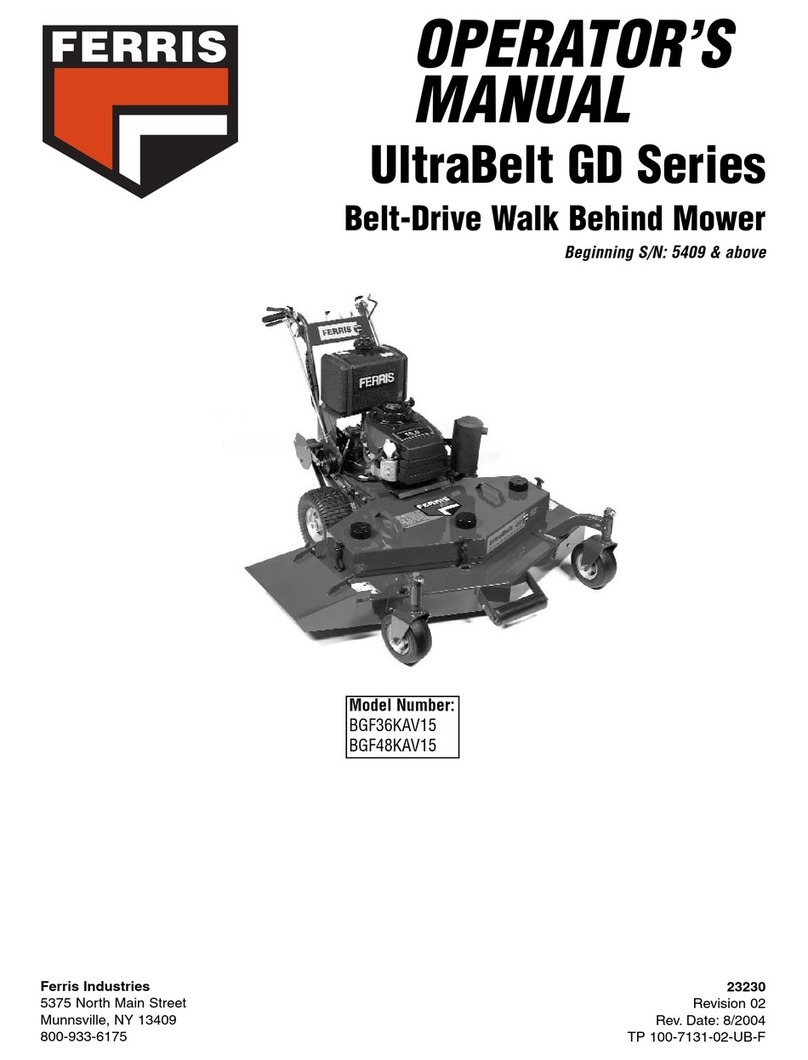
Ferris
Ferris UltraBelt GD BGF36KAV15 Operator's manual
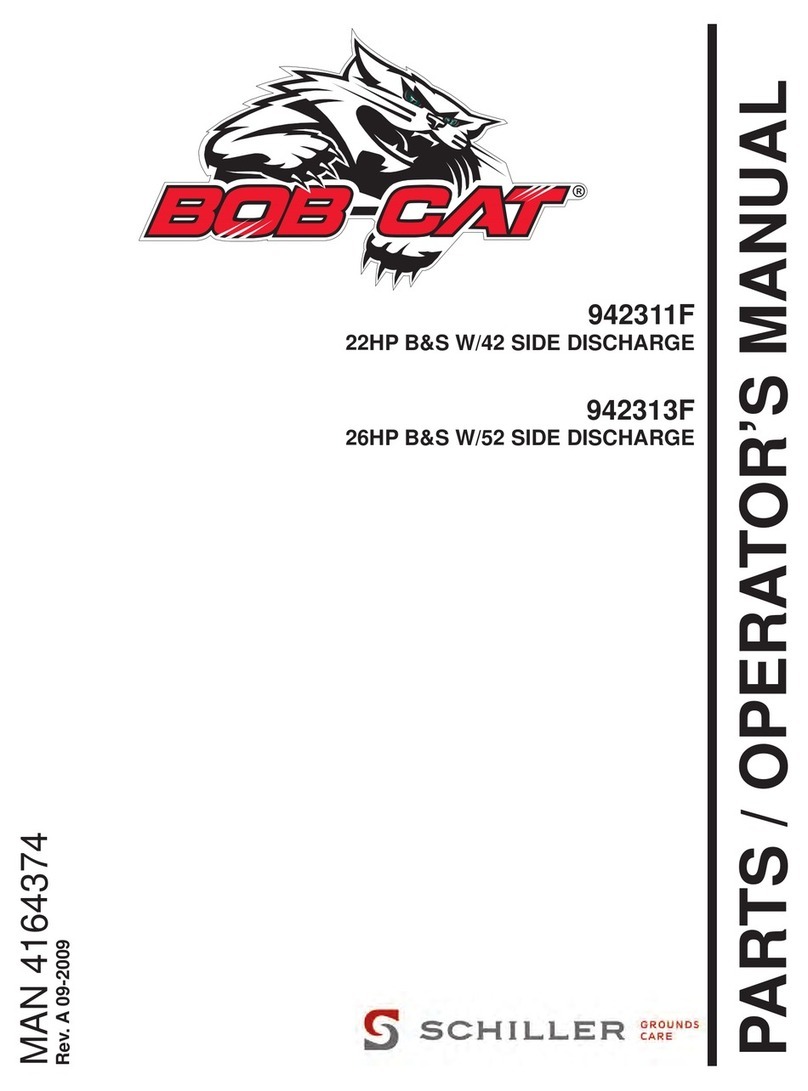
Schiller Grounds Care
Schiller Grounds Care Bob-Cat 942311F Operator's manual
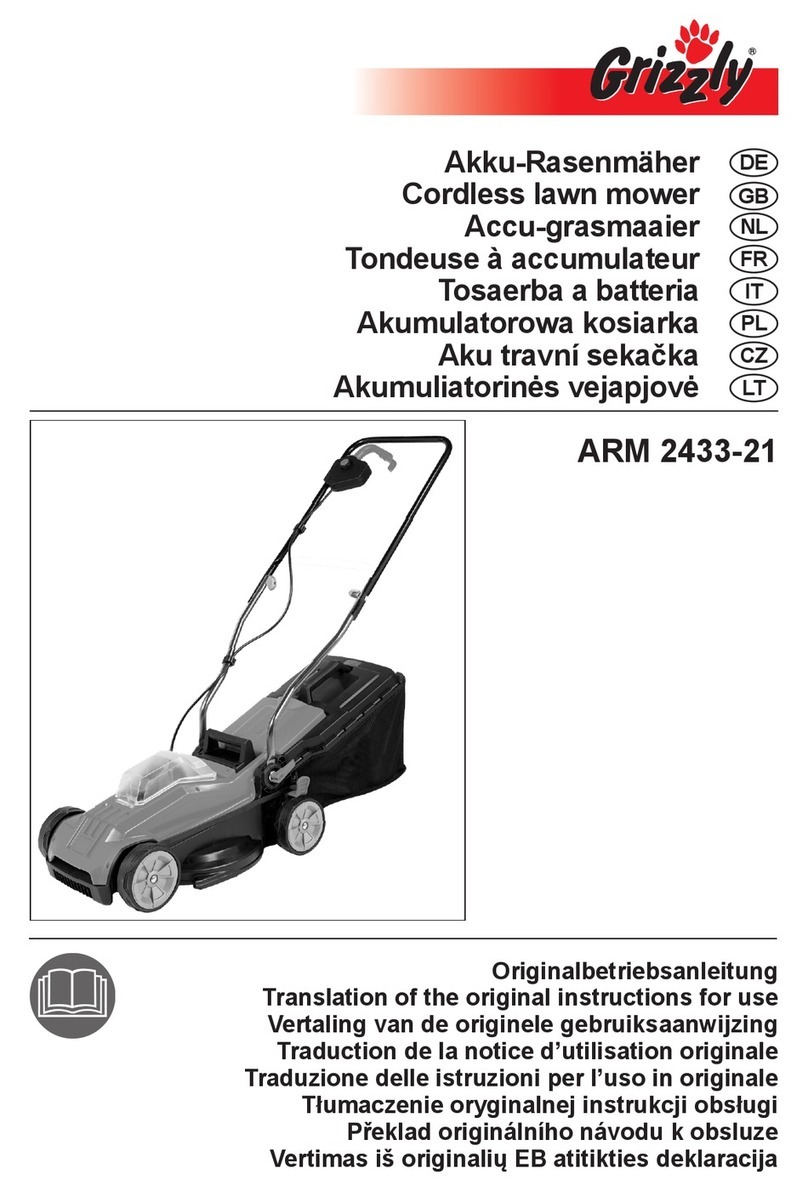
Grizzly Tools
Grizzly Tools ARM 2433-21 Translation of the original instructions for use

Worldlawn
Worldlawn Venom WYS48FX730VL Operator's manual
